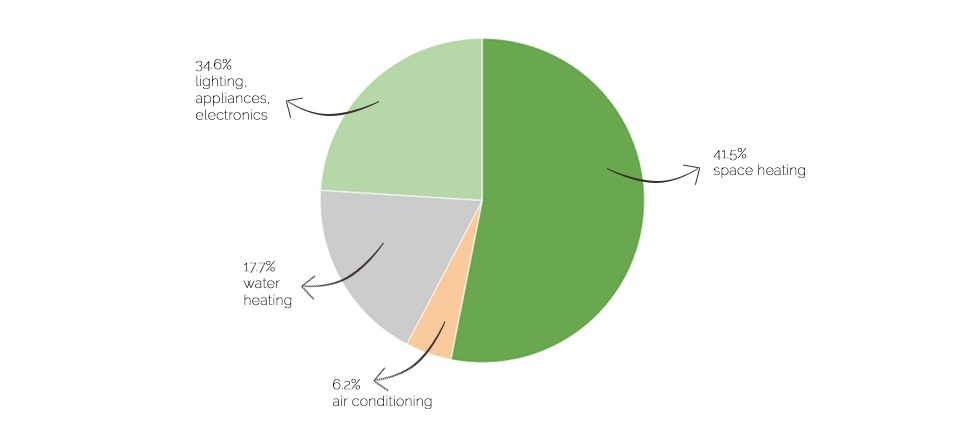
A lot has changed since the first celebration of the International Earth Day on April in 1970. What began as hopes and dreams of creating a healthier, more sustainable environment, has turned into actions that save energy and contribute to a cleaner planet. And we are all part of it.
These days the celebration of this environmental movement is a great opportunity to take a look at the ways we can protect and conserve Mother Earth. As buildings account for 40% of total energy consumption, they represent a considerable energy and money savings potential.
What if your home could be programmed to save you energy every chance it got? Energy saving smart devices are no longer a thing of the future. Recent eruption of smart home technology has given us everything from smart lights that turn off automatically, smart power strips that can “unplug” devices not in use, thermostats that learn when users are home and more.

We’ve collected these 5 suggestions on how you can celebrate this year’s Earth Day by making your home’s energy consumption smarter:
1. Invest in a smart thermostat
Why waste money and energy heating and cooling empty spaces? Take control to drastically cut back on energy consumption.
Lowering energy used to control your home’s temperature is an effective way to protect the environment and cut the bills at the same time. Smart thermostats give you the ability to remotely control the temperature in your home, set an automated schedule or change the temperature on the fly—all through your smartphone or by using voice control. Programmable thermostats can easily help you save even up to 25% on the monthly bill.
Have your heating think like you do, know when you’re home and learn to optimize itself. It can provide warmth on cold winter days and keeps your home cool on hot summer days only when needed.
It doesn’t matter which type of heating you have – it’s possible to make it smarter by getting a smart thermostat to upgrade the existing one.
We recommend:
Nest
Honeywell
Ecobee4

2. Learn about querying
"Did I leave the lights on in the kitchen?"
Leaving lights, fans, speakers, humidifiers, and more running while you're out of the home is a huge waste of electricity. Even if you opt for LED bulbs, it's a good practice to switch off devices you aren't using. With a connected home, the question, "did I leave the lights on in the kitchen?" gets an instant response — you don't have to wait until you get home.
You'll be able to save money and reduce uncertainty in one move!
1Home enables querying as well as connecting several smart devices, from voice assistants, watches, phones, tablets etc.
3. Install smart lights
Forgot to turn the lights off when you left home?
No problem.
Similar to smart thermostats, smart lights let you control the lights, set automated schedules and all together cut back on the amount of electricity that gets wasted on unnecessary lighting.
Lighting is second to excessive heating when it comes to reducing the monthly bill. A smart lighting system can dim, turn off, or change the color of your bulbs for maximum energy savings.
If you're buying smart bulbs, you're buying energy-efficient bulbs. LED lighting is the way of the future and for good reason: They last an incredibly long time (cca 25 years) and they use way less energy than the bulbs of yesteryear. This kind of low voltage lighting will save you 30% of your lighting energy costs compared to the traditional lighting concept.
We recommend:
Philips Hue
LIFX
4. Get some smart plugs
If you want to do your part for Earth Day but aren’t quite ready to embark on a big smart-home overhaul, that’s okay, too. There are simple steps you can take to outfit your home with eco-friendly smart home products that are user-friendly, even for beginners.
A smart plug can turn any device into a smart device just by plugging it into a smart plug and plugging this into the wall socket. You can then turn any device on/off with a tap of the button, voice control your devices or monitor your energy use from anywhere in the world.
Standby power use is a significant contributor to energy wastage and unnecessary expenses, contributing to about 16% of the electricity bill. Smart power outlets enable you to monitor and restrict energy drain via the sockets, which can save you up to 16% of the electricity bill.
We recommend:
iDevices Switch
TP-Link
ZigBee Plug-In
5. Set up routines
When leaving home, activate the “Away” routine. The garage door will close, lights and music in the whole house will go off, the TV will switch off and the alarm system will be activated.
This and a number of other routines can be set up with your smart assistant of choice to make your smart home blend with your daily habits and save energy at the same time. We have written extensively on this topic HERE to learn how to set up your own routines and get ideas for new ones.
If you'd like to create a routine that include all of your Loxone, Gira or KNX devices, make sure to connect your Amazon Alexa or Google Home to them.
See how to connect and create routines:
For Amazon Alexa and a Loxone smart home
For Amazon Alexa and a Gira smart home
For Amazon Alexa and a KNX IP Interface
For Google Home and a Loxone smart home
For Google Home and a Gira smart home
For Google Home and a KNX IP Interface.
For Apple HomeKit and a Loxone smart home
For Apple HomeKit and a Gira smart home
For Apple HomeKit and a KNX IP Interface
The question remains: Can all smart devices save our planet? 🤔
Yes. But also no.
Yes, smart home devices can save resources. No, not all of them will. Some, such as always-on connected cameras actually use more, because they’re not replacing an energy load, they’re adding one (although not a significant one). Others, the ones mentioned above, are forging a path to a brighter, greener future.
In a 1Home connected smart home, all of the devices work together – from the IoT to hard-wired KNX devices – creating a more comfortable, energy-efficient space for you and your family.
